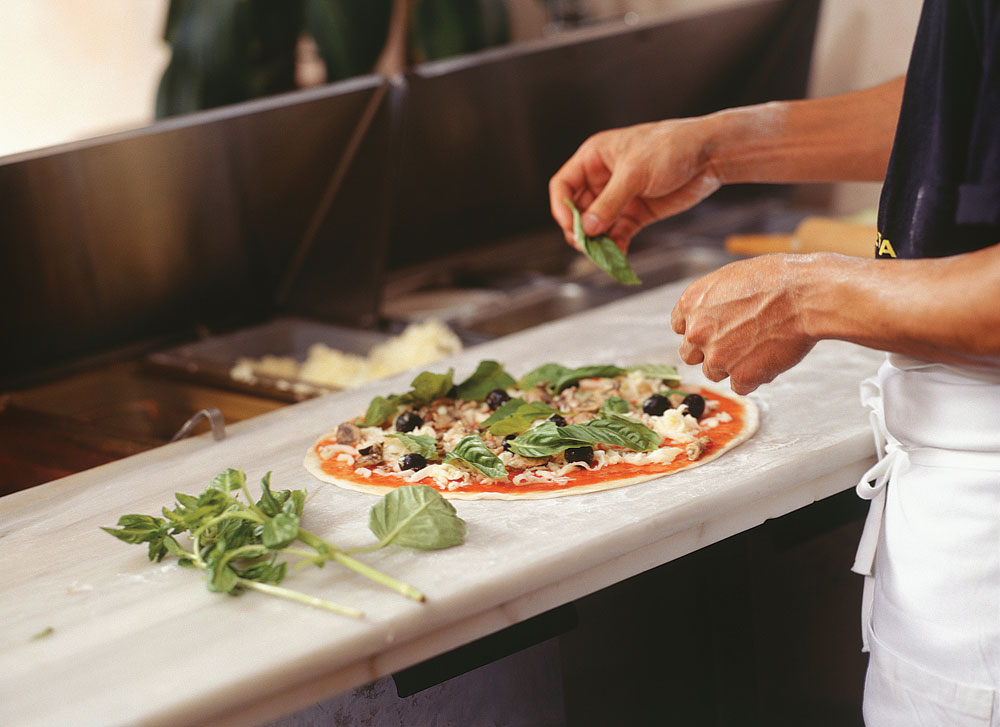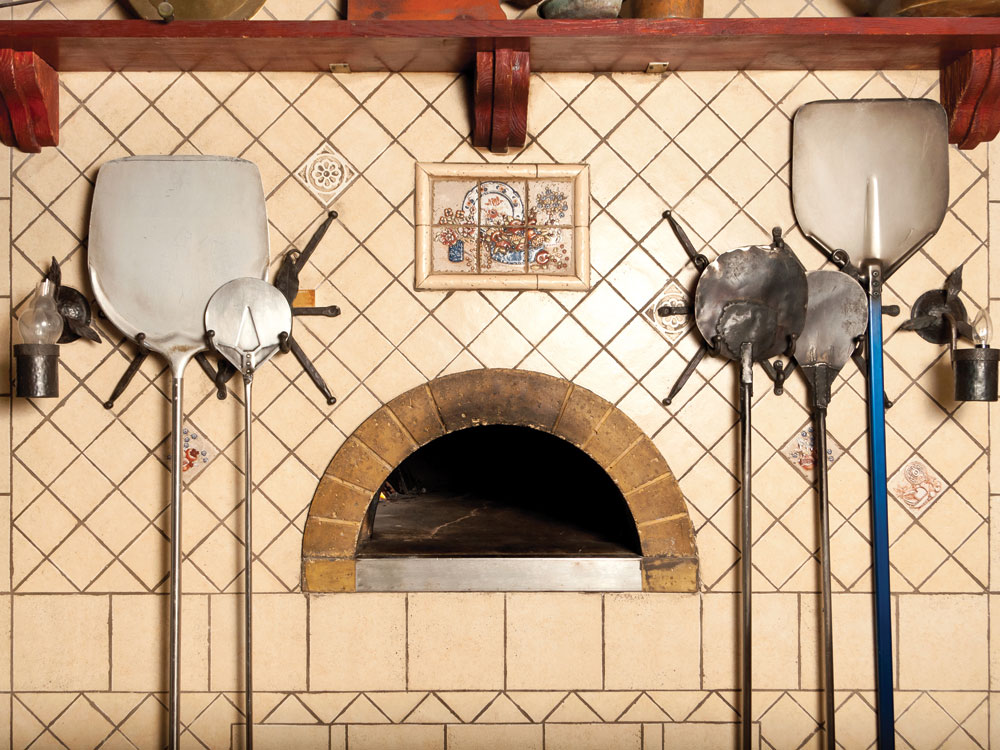If you’re thinking of opening your own pizzeria, you already have plenty to consider. Do you want to buy or lease a building? What will the menu offer? How can you successfully market the business? But you’ll also have to think of other logistics—including what equipment you’ll need to get up and running. We spoke to industry experts and restaurant consultants to create a list of the basic equipment required for making the leap from aspiring owner to pizza entrepreneur.
Know Your Concept
On the subject of opening a pizzeria, experts agree on one crucial tenet: Know everything you can about your business before you think about equipment. “You’d be surprised how many people don’t have their menu put together but have already ordered equipment, and they often overbuy,” says “Pizza Paul” Nyland, a consultant based in Grand Rapids, Michigan, who worked for Gordon Food Service for more than 30 years. “Create your menu first, get together with your distributor and distributor’s salesperson, and then determine what equipment you’ll need.”
Danny Bendas, managing partner at Synergy Restaurant Consultants in Irvine, California, agrees that an owner must have a complete understanding of the brand before purchasing equipment. “What’s the size of your menu and the size of your pizzas?” he asks. “Will you have a build-your-own concept or offer a high-end menu with fewer choices? Determine the concept to develop and design a space plan. How much square footage is needed? Will you have seating or offer delivery only?” Bendas calls this first step the “discovery phase”—when future owners develop the concept to make way for more detailed plans on how everything will flow in the restaurant. “You can’t do anything until you have a complete understanding of the brand, including niche, concept and target demographic,” he says.
Generating Heat
The type of pizza you’ll offer will influence your most major piece of equipment—the oven. “What is your style of pizza, and what capacity do you want?” asks Bendas, who notes that popular pizzeria choices include deck ovens (sometimes with cement or stone decks) and easy-to-operate conveyor ovens. “What’s the level of quality you want? What is the required throughput?”
Andre Neyrey, a former pizzeria owner and current owner of Manhattan Restaurant Consultants in New York, notes that conveyor ovens are quick and easy for staff because the timing is set and operation is a no-brainer. Deck ovens require more knowledge for working the oven and placing the pizzas, while wood-fired types require the most expertise. Hence, your staff members’ ability to operate the ovens will be a key factor. You must also determine if you’ll offer thin-crust, thick-crust, deep-dish pizzas or a combination—not all ovens suit certain pizza styles.
Tom Lehmann, director of bakery assistance for the American Institute of Baking in Manhattan, Kansas, often consults for aspiring pizzeria owners and emphasizes familiarity with concept and pizza style when choosing an oven. “Are you fine-dining or Joe Schmo?” he asks. “Is it casual, a slice operation, a grab-and-go? If you’re a grab-and-go, why have a wood-burning oven? Maybe productivity is more important. Or maybe you want to have more toppings than anyone else—so why get a deck oven when an air impingement oven will create a pie without sogginess?” Location of your business will also matter—if you’re located in a strip mall, chances are you won’t be able to install a wood-burning oven. “Do some soul-searching, and ask what you want to be to your customers,” Lehmann advises.
A mix of ovens might be necessary for your particular combination of menu items. Nyland has seen some pizzerias make their pizzas in deck ovens while cooking their breadsticks and sandwiches on conveyors. Lehmann points to a slice operation in his area that uses a deck oven to heat entire pies, but, when individual slices are topped to order, they’re finished in an impingement oven. Meanwhile, Nyland notes that a split conveyor may be useful; it has two sides that run at different speeds to accommodate different cooking times.
 |
|
In any pizzeria, smallwares will also be necessary, including such items as rocker knives and rolling cutters, pizza peels (metal or wooden), pots and pans and cooking utensils. |
Dough On the Go
The dough making process is a major consideration for operations that don’t buy premade. Again, knowing your concept will help you understand your needs—such as a mixer, a dough prep table, and perhaps a rounder, press or sheeter. Lehmann tells owners to buy a mixer no smaller than 60-quart, although most operators won’t need anything bigger than 80-quart. Nyland recommends nothing under 40-quart because a 40-quart will take a 25-pound bag of flour (in other words, think about the raw ingredients you’ll be buying when considering equipment needs). Nyland prefers horizontal mixers, but VCMs develop dough at lightning-fast speed—do some research to determine which is best for your dough and operation.
Sheeters can be useful for employees who can’t properly open a dough ball. “You can preopen with a sheeter (running a dough ball through to ⅔ or ¾ of the finished diameter) and finish by hand to keep the porosity and beautiful raised edge of a hand-tossed style,” Lehmann explains. “For truly minimum skill sets, look into a dough press—it requires the employee only to put in a dough ball and press two buttons, then take it off.”
Neyrey adds that, for communities with poor-quality water, a water filtration system is crucial for great dough; a conditioning treatment, triple-filtering system or reverse-osmosis treatment can help prep one of your most basic dough ingredients.
-Tom Lehmann
Prep and Storage
Neyrey recommends purchasing stainless-steel sheet pans or other dough storage containers; stainless-steel prep tables for work service; a prep sink; walk-in refrigeration (cooler and freezer); a reach-in refrigerator/freezer; and double-pass-through, stainless-steel shelving. A pizza table as long as the oven (8’ to 9’), placed across from the oven—with all toppings, sauce and cheese needs laid out—will make prep a breeze. “In a kitchen, you want everything within arm’s reach,” says Neyrey.
For refrigeration or other major-equipment needs, Bendas strongly advises against buying used equipment unless the operator is sure of the quality, as a lot of mechanical parts can go awry. “Ask if the refrigeration’s compressors are built-in or remote because that will affect the heat in the kitchen,” Bendas says. “But, in general, energy-efficient appliances of any type are important.” He recommends walk-ins, which are more space- and cost-efficient, over using several refrigerators for storage. Bendas also adds that fledgling operators should consider whether they will be offering gluten-free products while in the planning stages; these will require separate areas for prepping, cooking, storing and related tasks.
Also see: Keep your cool and boost your bottom line with energy-efficient refrigeration equipment
Nyland recommends a three-door make table and a specialty rack for sheet pans that can hold dough balls of varying sizes. “A lot of people have two make tables—one for sandwiches and one for the pizza line,” he says. “Keep the dough underneath and the sauce/cheese/toppings on top, and keep that table close to the oven and the table where you’ll cut and finish.”
 |
|
A pizza table as long as the oven (8’ to 9’), placed across from the oven—with all toppings, sauce and cheese needs laid out—will make prep a breeze. |
Running a Tech Check
POS systems are must-haves for all but the most old-fashioned pizzerias, and they tend to come with plenty of bells and whistles. According to Bendas, the essentials include: a way to maintain a customer database with addresses (including the ability to do marketing with that database, such as through social media and email blasts); a GPS service for deliveries; and an option for mobile/Internet ordering.
Also see: Cutting-edge POS systems are working smarter and harder for you and your customers
“You want a POS with a delivery module that offers ways of tracking guests; email and social networking programs; inventory tracking; sales information; and ways to balance out the register with credit card payments,” Neyrey suggests. Ask for demos from POS manufacturers as well as recommendations from pizzerias similar to yours in noncompeting areas.
Start to Finish
When equipping your pizzeria, think about the entire pizza making process—first, what’s needed in the before-oven steps, “from the dough to the sauce to the cheese/toppings to the oven,” Bendas says. “Then you need to think about the landing and cutting table as well as the plating/boxing/finishing area. How is everything going to flow?” He suggests working from the back forward—from the supplies coming in the back door to the finishing and pickup/delivery station up front. Bendas also advises owners to think about what else will be prepped on-site. If you’re making your own sauce or grilling toppings, you’ll need an oven range or grill, for example. Also consider concept: Do you need serviceware and tables for dine-in customers, boxes for delivery/takeout, or display cases for grab-and-go items?
Delivery and carryout operations also require a place to hold pies (such as heated cabinets), hot bags and boxes—all while maintaining top-notch pie quality—plus other packaging and disposable utensils, napkins and similar items, Bendas notes. But dine-in has its own challenges, requiring equipment for warewashing (i.e., a three-compartment sink) and glassware. For dine-ins, Neyrey adds, “You need a sound system/music service and dine-in furniture—tables, chairs, barstools and patio furniture, plus baby chairs, high chairs and booster seats for kids.” In delivery and takeout operations, he advises branding items such as pizza boxes, hot bags and takeout equipment for marketing purposes. He also advises you to ask for samples from container/box manufacturers to see how well your products hold up over time in those containers.
In any pizzeria, smallwares will also be necessary—Neyrey mentions rocker knives and rolling cutters, pizza peels (metal or wooden), pots and pans, cooking utensils (such as spoons and tongs), food storage containers, a rolling dough rack and a can opener, to name a few. For deep-dish pizzas, Lehmann suggests pan grippers and long-blade spatulas (as opposed to knives) to avoid damaging pans when extracting the pizzas.
Additionally, Neyrey observes, you’ll need to satisfy health department requirements (i.e., restroom supplies and a mop sink) and take care of security needs (installing an alarm system, surveillance and a safe). Finally, don’t forget your beverage service—you may need a soda fountain, an ice machine or ice maker, a bottle cooler and/or a kegerator (which allows for two to three beers on draft without a complete draft system). Make a list of everything you’ll need to stock before you begin, and work with your distributor to determine your best options.
Ultimately, no matter how you plan for immediate concerns—getting your pizzeria up and running—you’ll also want to look a bit further into your future. “Have a three- to five-year plan before you even think about equipment,” Lehmann urges. “If you don’t have room to grow, you can’t offset a rise in cost of ingredients unless you raise prices or lower your profit margin—either of which can put you out of business.”
Looking to open a new pizzeria? Check out PMQ’s Pizza Pages—a categorized listing of everything you’ll need for a successful operation—at ThePizzaPages.com.















